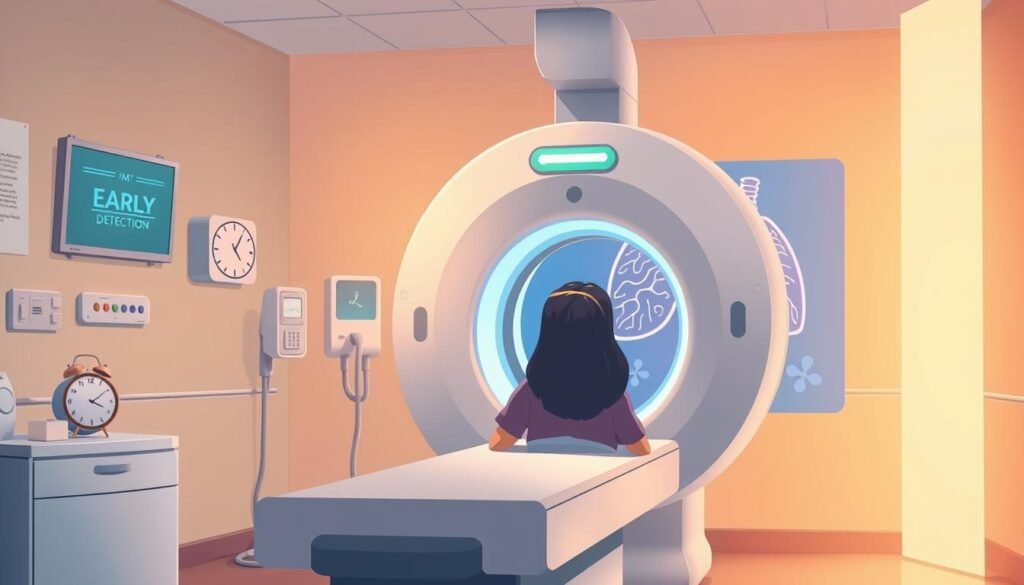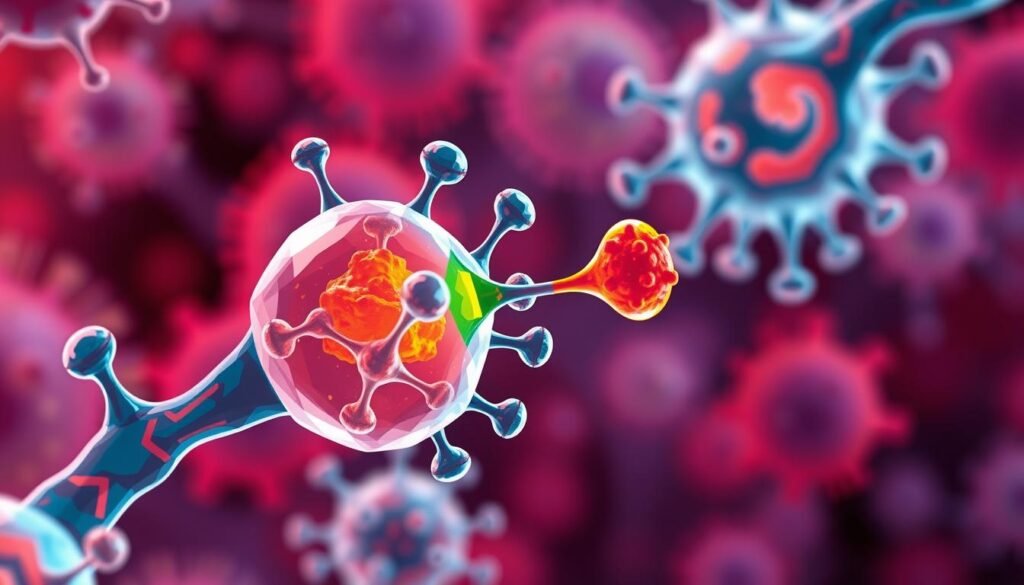Did you know that up to 70% of people respond to chemotherapy for small cell lung cancer (SCLC)? This fact shows how chemotherapy can really help, even though SCLC is a tough cancer to fight. About 14% of all lung cancers are SCLC, and it’s often found when it’s already advanced. That’s why it’s key for patients and their families to know about all the SCLC treatment options out there.
In the past few years, there have been big steps forward in treating SCLC. These have come from new therapies being developed alongside the standard ones like chemotherapy and radiation. Since SCLC is usually found after it has spread, these new treatments offer hope to those fighting this hard battle. In particular, immunotherapy is an exciting new area being added to treatment plans.
Adding these new therapies to treatment plans aims to make things better for patients. It’s really important to stay up-to-date with the latest research and advice. For more information on treatments, check out this resource.
Key Takeaways
- SCLC response rate to chemotherapy can be as high as 70%.
- Most patients are diagnosed at an extensive stage of the disease.
- New therapies like immunotherapy are changing the landscape of SCLC treatment.
- Established treatments include chemotherapy and radiation therapy.
- Understanding the latest advancements is crucial for effective patient care.
Understanding Small Cell Lung Cancer (SCLC)
Small cell lung cancer is known for being very aggressive, making up 15% of lung cancer cases in the U.S. Mainly, it’s caused by tobacco use, from smoking cigarettes, pipes, or cigars. Other risk factors are being around asbestos, radiation, secondhand smoke, and air pollution.
The most common form of this cancer grows quickly and is likely to spread early. This means most patients find out they have it when it’s already advanced. Studies show that 60% to 70% of people diagnosed have widespread disease, which reduces their treatment options and worsens their outlook.
Knowing the signs of lung cancer is key. Symptoms often include a lasting cough, feeling short of breath, and pain in the chest. They can get worse, leading to wheezing and coughing up blood. To diagnose it, doctors use chest x-rays, CT scans, checking spit under a microscope, and procedures like needle biopsies and looking inside the lungs with a camera.
Unfortunately, small cell lung cancer doesn’t often lead to long-term survival. Less than 7% of patients live more than five years after being diagnosed. Surgery isn’t usually an option because the cancer tends to have spread by the time it’s found. But there are treatments being studied, like chemotherapy and new immune therapies. Clinical trials are crucial as they test new ways to treat this cancer, through new treatment options and targeting specific parts of the cancer.
| Characteristic | Details |
|---|---|
| Prevalence | Accounts for approximately 14% of all lung cancers |
| Risk Factors | Smoking, secondhand smoke, asbestos, radiation, and air pollution |
| Common Symptoms | Coughing, shortness of breath, chest discomfort, and wheezing |
| Diagnosis Methods | Chest x-rays, CT scans, sputum cytology, biopsies |
| Five-Year Survival Rate | Less than 7% overall |
| Extensive-Stage Diagnosis | Observed in 60%-70% of cases |
Incidence and Prognosis of SCLC
It’s key for both patients and doctors to grasp the facts about small cell lung cancer (SCLC). Every year, around 30,000 people in the U.S. are told they have SCLC. It makes up about 14% of lung cancer cases. Interestingly, 2 to 3% of these patients have never smoked. The clear connection between tobacco use and SCLC stresses the need for ways to avoid this disease.
Statistics on SCLC Cases
Young women are more often diagnosed with SCLC than young men. It’s important to note these differences to fully understand the disease’s impact. Recent science has divided SCLC into four specific types. Each type has its own weaknesses that treatments can target. This finding highlights the push for treatment plans that are specific to each patient’s disease type.
Survival Rates and Factors Influencing Prognosis
The chance of surviving SCLC for five years is only 6%. Even with new treatments, survival is low. This is because SCLC grows fast and spreads early. How well tumors respond to treatment affects chances of survival. Response rates to initial treatments can be as high as 60-80% in early-stage cases. But, only about 20% of these patients are cured.
How well additional chemotherapy works also varies a lot. For disease that’s still sensitive, the response rate is about 25%. It’s less than 10% for disease that’s stopped responding. Quitting smoking after getting diagnosed early can lead to better outcomes. This shows how changing lifestyle habits can affect survival chances.
Stages of SCLC
Small cell lung cancer (SCLC) has two main stages: limited-stage and extensive-stage. Each stage impacts the treatment approach and the likely outcome.
Limited-stage SCLC is when cancer is on one side of the chest, including nearby lymph nodes. Treatment usually combines chemotherapy and radiation therapy. This aims to target the tumor and manage symptoms. Many patients get aggressive treatments like chemoradiotherapy.
Extensive-stage SCLC means the cancer has spread beyond the lungs to other organs. Treatment mainly involves chemotherapy, sometimes followed by radiation to the lungs. New treatments like immunotherapy with drugs like atezolizumab or durvalumab are being used more often.
Knowing the stage of SCLC is crucial for choosing treatments. A team of doctors, including oncologists and nurses, makes treatment plans. They consider the SCLC stage and the patient’s overall health.
Understanding stages of SCLC helps patients and families know what to expect. It guides them through treatment, aiming for the best results.
Importance of Early Detection
Finding SCLC early can really help with treatment. It means doctors can start helping sooner, which might let people live longer and better. There are a few symptoms that come up often. These signs mean it could be small cell lung cancer.
Symptoms to Watch For
Knowing what to look out for is key. Here are the main symptoms:
- Persistent cough
- Chest pain
- Unexplained weight loss
- Shortness of breath
- Fatigue
Being aware of these signs helps catch SCLC early. This means getting the right help quickly.
Screening Challenges for SCLC
Screening for lung cancer, especially SCLC, is tough. Most of the time, it’s found late because there aren’t clear rules for checking it. The cancer grows fast, so symptoms don’t show until it’s pretty advanced. This makes treating it harder and can worsen the outcome.

Chemotherapy, Radiation, and New Treatment Options for SCLC
Small cell lung cancer (SCLC) treatment has changed a lot, combining old and new ways to improve results. Chemotherapy is still key, together with radiation therapy, to fight this aggressive cancer. Now, targeted therapy and immunotherapy bring new hope to those with SCLC.
Traditional Chemotherapy Approaches
Chemotherapy for SCLC aims to shrink tumors as much as possible. Most patients, about 70%, see their tumors shrink with this treatment. But, it’s important to know that this effect doesn’t last long. Cancer often comes back quickly, within six months.
Advancements in Radiotherapy Techniques
Radiation therapy is crucial for SCLC, especially if the cancer hasn’t spread much. New ways of doing radiotherapy let doctors target tumors more accurately, protecting healthy tissue. This makes the treatment more bearable and effective for SCLC management.
Emerging Treatment Options: Targeted Therapy & Immunotherapy
New treatments like tarlatamab are showing a lot of promise. In one study, 40% of SCLC patients who got 10 mg of tarlatamab every two weeks saw their tumors shrink significantly. This is better than what was seen with other treatments, and the effects lasted over six months for many.
Immunotherapy is changing the game for SCLC care. With trials of tarlatamab and others ongoing, long-lasting results seem more likely. For people with SCLC, these new therapies offer hope with less harm and easier side effects than traditional chemotherapy.
Latest Advances in Clinical Trials for SCLC
The landscape of clinical trials for SCLC has evolved significantly, offering hope for new treatments that could change patient outcomes. Recent advancements highlight the importance of ongoing research and patient participation in clinical studies.
One notable achievement includes the FDA approval of Imdelltra (tarlatamab-dlle), which demonstrated a remarkable 44% response rate among patients in clinical trials. This experimental treatment has shown promise for extensive-stage SCLC. It grants an avenue for patients who have progressed on standard therapies. Similarly, the approval of Cosela (trilaciclib) marks a leap forward. It helps manage chemotherapy-induced myelosuppression for those with extensive-stage SCLC.
Further noteworthy progress involves the combination of durvalumab and chemotherapy. This extended median survival to 13 months for half of the participants, significantly better than chemotherapy alone. Zepzelca (lurbinectedin), with a response rate of 35%, showcases another promising option within ongoing clinical trials. These findings underscore the critical role of SCLC research advancements in refining and developing treatment protocols.
Looking towards the future, several promising clinical trials are underway. Studies on Ivonescimab, PM8002, and IBI3009 aim to enhance therapeutic options for SCLC patients. The engagement of patients in these clinical trials facilitates the exploration of new drugs and combinations. These could ultimately redefine care standards.
- Upcoming Phase 3 trials for drugs like YL201 and ZG006 may yield vital insights into their safety and efficacy.
- Studies investigating immune checkpoint inhibitors, specifically in extensive-stage SCLC, are likely to yield data that could influence future treatment protocols.
- The focus on genomic profiling in clinical studies shows promise in tailoring treatments to individual needs, particularly in nonsmokers with SCLC.
Integration of experimental treatments from these trials will shape the future of SCLC management. Continued investment in clinical trials for SCLC remains essential. This is crucial for developing effective treatment options that meet the needs of patients facing this challenging diagnosis.

Managing Side Effects During Treatment
Treatment for small cell lung cancer involves challenges, especially with side effects. Knowing the common side effects of chemotherapy and radiation is key. It helps manage them effectively. This care improves the patient’s life and well-being.
Common Side Effects of Chemotherapy and Radiation
Many patients face chemotherapy side effects. Common ones are:
- Nausea and vomiting
- Diarrhea
- Constipation
- Tiredness
- Pain
- Loss of appetite
- Hair loss
- Skin and nail changes
- Numbness and tingling
- Swelling
Radiation therapy also causes side effects such as:
- Nausea and vomiting
- Fatigue
- Hair loss
- Skin changes
Talking about your side effects is crucial. It helps make a plan that meets your needs.
Supportive Care Strategies
Supportive care strategies are key in side effects management. They include:
- Eating well to fight loss of appetite
- Drinking plenty of fluids to ease nausea and constipation
- Light exercise to lessen fatigue
- Using medicines or natural solutions for nausea or pain, as advised
Adding supportive care helps patients focus on recovery while keeping symptoms in check. Knowing about side effects allows patients and doctors to improve treatment experiences together.
Role of Targeted Therapy in SCLC Treatment
Targeted therapy for SCLC searches for specific molecular targets related to cancer. It aims to stop the cancer cells from growing and spreading. Knowing how targeted therapy works shows us its potential and its limitations.
Mechanisms of Action
The tasks of targeted therapy include stopping the signals that help cancer cells survive. For SCLC, these include stopping blood vessel growth, fixing DNA, and changing cell signals. The most studied targets in SCLC are:
- VEGF inhibitors: These target vascular endothelial growth factor to reduce tumor blood supply.
- PARP inhibitors: These disrupt DNA repair mechanisms, making cancer cells more susceptible to damage.
- mTOR inhibitors: These act on nutrient-sensing pathways critical for cancer cell growth.
Turning these targeted therapy ideas into successful treatments for SCLC remains hard.
Examples of Targeted Therapies
There are several examples of targeted therapies for SCLC. None have changed survival rates yet, but some look promising in trials:
| Targeted Agent | Mechanism | Clinical Result |
|---|---|---|
| Bevacizumab | VEGF Inhibition | Varied results in combination with platinum-based chemotherapy. |
| Topotecan | Topoisomerase I Inhibition | Approximately 20% overall response rate in recurrent SCLC. |
| Lurbinectedin | Transcription Regulation | 35% overall response rate in a phase II trial for relapsed SCLC. |
| Pembrolizumab | Immune Checkpoint Inhibition | 33.3% overall response rate in third-line relapsed SCLC. |
This information about treatments points out the future of targeted therapies in SCLC. Researchers keep looking for better ways to fight this tough cancer.

Immunotherapy: A New Frontier in SCLC
Immunotherapy is changing the way we treat small cell lung cancer (SCLC). It uses the body’s immune system to fight cancer. This is a fresh approach, different from usual treatments. Understanding immunotherapy is key to seeing its impact on lung cancer.
Understanding How Immunotherapy Works
Immunotherapy boosts the body’s defense against cancer. It doesn’t attack tumors directly. Instead, it makes the immune system target cancer cells. Treatments like nivolumab and durvalumab reawaken the immune response. This leads to better results for many patients. It’s a big step forward in SCLC treatment.
Recent FDA Approvals for SCLC Immunotherapy
Recent approvals have changed lung cancer treatments. Atezolizumab with chemotherapy has shown better survival in advanced SCLC. Trials like CASPIAN and ASTRUM-005 have shown good results. These new therapies are now part of standard care. This means more personalized treatments and better chances for patients.
| Treatment | Trial Name | Overall Survival (OS) | Progression-Free Survival (PFS) |
|---|---|---|---|
| Atezolizumab + Chemotherapy | CASPIAN | HR 0.73 | Significant Improvement |
| Pembrolizumab | KEYNOTE-604 | No Improvement | HR 0.80 |
| Adebrelimab + Chemotherapy | CAPSTONE-1 | HR 0.72 | Improvement Observed |
| Serplulimab + Chemotherapy | ASTRUM-005 | HR 0.63 | Prolonged Survival |
These improvements mark a new chapter in SCLC treatment. With immunotherapy, there’s new hope for people with this tough cancer. As we keep researching, treatment for lung cancer will only get better.
Supportive Care and Patient Resources
Getting diagnosed with small cell lung cancer (SCLC) is tough. Supportive care is key to enhance life quality. It looks at physical, emotional, and psychological help for patients. Supportive care SCLC offers resources to tackle these challenges well.
Emotional and Psychological Support
Feeling emotionally supported is crucial for those facing cancer. The American Cancer Society gives access to patient resources. These include counseling, support groups, and one-on-one mentoring. All aid emotional health.
Contact with fellow survivors is beneficial. It builds a community that understands. Sharing stories and feelings reduces anxiety and fear.
Nutritional and Rehabilitative Resources
A healthy diet supports healing during SCLC treatment. Specialized nutritional guidance is designed for cancer patients’ needs. Dietitians create easy-to-digest, nutrient-packed meal plans.
Discover recipes and tips through online resources. These are made for lung cancer patients’ needs. Plus, rehabilitative care offers recovery support. It provides access to physical activity and wellness programs.
Clinical Trials: Opportunities for Innovation
Small Cell Lung Cancer, or SCLC, poses big challenges for those seeking treatment. Getting involved in clinical trials can offer new therapies not widely available. Knowing how to find and join these trials could lead to better treatment results.
How to Find and Participate in Clinical Trials
Looking for SCLC clinical trials is easier with the right tools. Here are some ways patients can start:
- Talk to their healthcare provider for information on current trials.
- Use online resources like ClinicalTrials.gov, which lists trials by cancer type and location.
- Contact research centers, such as the UVA Cancer Center. They offer both treatment and research opportunities.
After finding a trial, it’s important to review the eligibility requirements. Then discuss the trial with your healthcare team. Knowing the details helps ensure you’re fully informed and supported.
Benefits of Joining Clinical Trials for SCLC Patients
Clinical trials bring several advantages for those with SCLC, such as:
- Getting new treatments: You might access therapies not available elsewhere.
- Better monitoring: Trial participants often get extra medical attention and care.
- Helping with research: Your participation can help improve treatments for future patients.
Learning how to join clinical trials empowers patients. It can greatly improve their treatment options and outcomes. By getting involved, they can help both themselves and others facing SCLC.
Conclusion
The ongoing research and SCLC treatment advances bring hope to those with small cell lung cancer. SCLC makes up about 15% of all lung cancer cases. It has a 90% or higher 5-year mortality rate. This shows a pressing need for treatments tailored to each patient’s needs.
A holistic view on lung cancer management is essential. It includes chemotherapy, radiation, targeted treatments, and immunotherapy. These can lead to better survival rates and life quality. For instance, recent trials show new therapies can improve patient outcomes when used with traditional treatments.
The future of lung cancer therapy depends on science and communication between patients and healthcare providers. Open talks help patients learn about new treatment options that could change their disease’s course. Personalized care, considering each patient’s unique situation, is key in fighting SCLC.